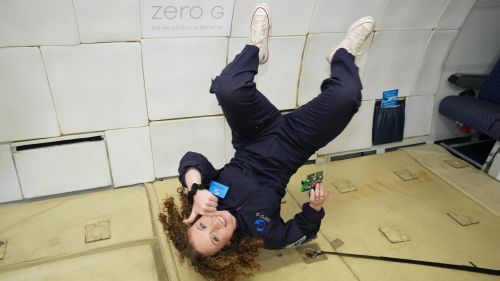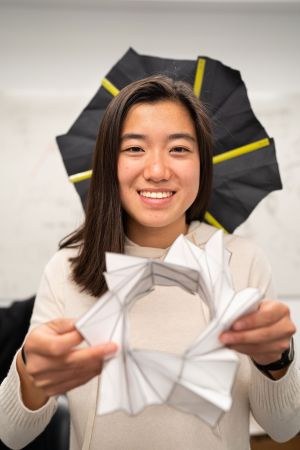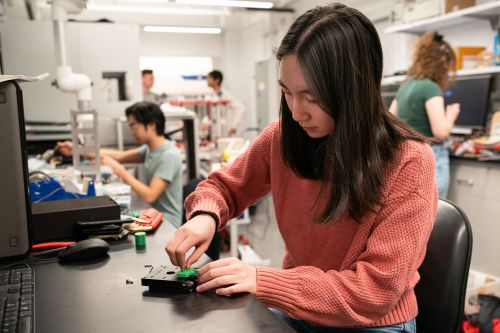
Shannen Prindle, who graduated from Princeton in 2023 with a degree in mechanical and aerospace engineering, tested three student-built systems for small satellites on board a Zero-G research flight. Photo credit: Zero Gravity Corporation and Steve Boxall
June 6, 2024
By Molly Sharlach, Office of Engineering Communications
The capstone of Shannen Prindle’s Princeton experience came nearly a year after she graduated. It began with a sensation of falling toward the ceiling, and ended with a game of grabbing floating jellybeans and globs of water in mid-air.
These otherworldly episodes bookended some serious engineering tests. This spring, Prindle, who graduated from Princeton in 2023 with a degree in mechanical and aerospace engineering, boarded a Zero-G research flight in Florida. Her aim was to test three student-built systems for small satellites called CubeSats, which are about the size of a loaf of bread. The flight consisted of 30 parabolic cycles that simulated space flight by allowing passengers (and their experiments) to experience weightlessness.
Prindle now works as a launch tower engineer for SpaceX’s Starship, which is the largest rocket ever built and could someday serve as a reusable vehicle for satellite launches and missions to the moon.
“When I started at Princeton, I didn’t even think I wanted to major in MAE, but I slowly discovered that I really like hands-on mechanical and structural engineering, and space systems,” she said.
As a first-year student, Prindle attended an interest meeting for the Princeton Rocketry Club, where she heard a talk by Michael Galvin. A senior technical staff member in MAE, Galvin had recently launched the TigerSats lab. He showed students how they could create their own systems for small satellites to withstand launch and collect images and data in low Earth orbit.
When she saw the possibilities of a CubeSat project, she thought, “Oh yeah, I’ve got to join,” said Prindle.
She is one of more than two dozen students who have worked in the TigerSats lab, designing and building novel satellite systems involving sensing, communications, flight mechanics, and ground testing — including eight students who have completed senior thesis projects advised by Galvin. These students have expanded the capabilities of low-cost satellite systems built with accessible tools, and many have gone on to careers at places like NASA’s Jet Propulsion Laboratory, Firefly Aerospace, and Skydio, a drone manufacturer.
“Being part of Mike’s lab, I was able to put all the theory and homework that I was doing into a very concrete project,” said Prindle, who was part of the lab’s inaugural ProtoSat project in 2019. During her junior year she built a solar charging simulator for CubeSats, and for her senior thesis she designed a system called a reaction wheel module for stabilizing and pointing CubeSats.
On the Zero-G flight, Prindle tested her reaction wheel, as well as another stabilization technology called a gravity boom, built by 2021 graduate Michael Hauge, and a suite of devices designed by 2023 graduate Kyle Ikuma for measuring a CubeSat’s velocity, acceleration and orientation. The experiment provided the first-ever zero-G performance comparison of 3 such devices popular in the CubeSat community.

“There’s so much richness in these projects for students, and not just mechanical engineering students, but also disciplines like electrical and computer engineering, and physics,” said Galvin.
“I try to tailor the projects to each student’s skill set, but also to their skill gaps,” he said, “rather than have them only work on what we absolutely need to get us to a launch. I think it’s working as an educational model.”
It’s one thing for students to design electronics for satellites and then send the plans to a company for fabrication, but quite another to make the components by hand or use an in-house prototyping machine — and build part of something that could function and collect data in space, said Galvin.

“With just undergrad-level hands-on fabrication skills, they can actually make a lot of these components and know that their handiwork is what’s going into space,” said Galvin, whose other roles at Princeton include serving on the staff of Princeton’s StudioLab makerspace and as principal mechanical engineer for the University’s Space Physics group.
Students are continuing to test systems for the Princeton CubeSat Kit, a way for the lab to share its expertise with others as well as enable more student-led projects at Princeton, said Galvin. The lab also has a growing number of experiments that are pushing the limits of student-built hardware on both orbital and suborbital launches. These launches range from free-flying satellites and hardware onboard the International Space Station, to high-altitude balloon launches and zero-G flights.
“We’re regularly getting things off the ground in some fashion,” said Galvin. “Anything that can get your experiments into space or a space-like environment is a good [return on investment] and good educational value.”
When it comes to small free-flying satellites, getting data back to Earth is a major challenge — one that the TigerSats team experienced firsthand on one of its early launches as part of a fleet of educational ThinSat experiments in 2021.
For her senior thesis, Candace Do, a 2024 MAE graduate, tested a tiny radio for a PocketQube, which is only one-eighth the volume of a CubeSat. Typically used for satellite phone connections on Earth, the radio could connect a PocketQube in low Earth orbit to a communication satellite at a higher altitude, which would then beam data back to Earth. The radio that Do tested is a fraction of the cost of those currently in use on small satellites. In her experiments, the radio successfully beamed data from indoors, through a rainy Princeton sky, to a satellite constellation at a 500-miles altitude, which itself then successfully downlinked her “Hello, World!” message. Do received the Morgan W. McKinzie ’93 Senior Thesis Prize at the MAE department’s Class Day ceremony on May 27.

“There’s no clouds in between” the PocketQube and the communications satellite, said Galvin, and “it’s a persistent satellite network that has full global coverage. If you can get it to work on Earth it’s going to work in space.”
Galvin feels he’s succeeded in building an undergraduate space program focused on technology development. For the moment, most of the work is “not cutting-edge science yet,” he said. “But if we can get the foundation in place, we may be able to start doing some real space science as well.”
In addition to the technology itself, the lab is training students for graduate work and careers in space systems. Hauge and Kevin Tong, a 2022 Princeton graduate, have earned master’s degrees at Georgia Tech’s Space Systems Design Lab, where Do also plans to enroll this fall. Hauge is now an engineer at NASA’s Jet Propulsion Laboratory, and Tong is at Firefly Aerospace in Texas.
Galvin himself earned a bachelor’s degree at Georgia Tech, and came to Princeton in 2009 for a master’s degree while working as an engineer at Lockheed Martin Space Systems in Pennsylvania. Jeremy Kasdin, now the Eugene Higgins Professor of Mechanical and Aerospace Engineering, Emeritus, hired Galvin as part of a team developing an exoplanet telescope in 2012.
Kasdin said that “we are trying to make science, but don’t ever forget that the real product is people,” Galvin recalled. “We’re generating students who leave Princeton and go on to create bigger and better things.”

Students are drawn to the TigerSats lab and to working with Galvin in part because he balances the lab’s priorities with “what you as a student would enjoy, and also what you would gain the most from,” said Prindle. She came to the lab with an affinity for building mechanisms, but was less experienced with electronics, and Galvin knew which project “would teach me those skills that I needed to refine.”
“It was just fun to come into the lab every week and talk with Mike,” she said. “You knew that you could turn around in your swivel chair and he would be there to help answer your question. I feel like I had one of the coolest thesis experiences because I had such an attentive and knowledgeable mentor.”
The TigerSats lab is supported by the MAE department, the School of Engineering and Applied Science, and Princeton’s Council on Science and Technology, as well as Rutgers University, the Virginia Commercial Space Flight Authority, and NASA’s New Jersey Space Grant Consortium. Prindle’s zero-G flight and a balloon launch experiment by Kevin Tong of the Class of 2022 were also supported by the Fred Fox Fund of Princeton’s Office of Religious Life.
A full list of students, projects and opportunities may be found on the TigerSats website.